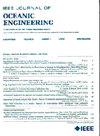深海网箱养殖的自监督水下智能感知
IF 3.8
2区 工程技术
Q1 ENGINEERING, CIVIL
引用次数: 0
摘要
在深海网圈养殖中,水下智能传感通过水下摄像机进行信息采集,但水下散射和吸收效应影响了水下信息的采集。由于网池养殖场景的水下数据集不可访问,使用神经网络处理网池养殖场景具有一定的挑战性。本文提出了一种基于同调约束和融合策略的自监督深海场景恢复方法。具体来说,场景辐射地图分别基于神经网络和先验提取架构,两种场景辐射地图源自两种不同的计算机制。最后,采用感知融合策略对两个场景辐射图进行融合,以获得更好的效果,并利用同调约束最小化误差。大量的实验证明,采用感知融合的方法具有良好的恢复能力。通过大量的实验证明,我们的方法在视觉质量和定量指标方面都优于最先进的方法。本文章由计算机程序翻译,如有差异,请以英文原文为准。
Self-Supervised Underwater Intelligent Perception for Deep-Sea Cage Aquaculture
In deep-sea net-pen aquaculture, underwater intelligent sensing is performed by an underwater camera for information acquisition, but underwater scattering and absorption effects affect the acquisition of underwater information. It is challenging to use neural networks to process the net tank aquaculture scenarios because the underwater data sets of the net tank aquaculture scenarios are not accessible. In this article, we propose a self-supervised deep-sea scene recovery method utilizing a homology constraint and a fusion strategy. Specifically, the scene radiation maps are derived based on a neural network and a prior extraction architecture, respectively, and two scene radiation maps originate from two different computational regimes. Finally, the perceptual fusion strategy is used to blend two scene radiation maps to obtain better performing results and minimize the error using the homology constraint. Extensive experiments confirm that the approach using perceptual fusion has excellent recovery capabilities. It is demonstrated through extensive experiments that our method outperforms state-of-the-art methods in terms of both visual quality and quantitative metrics.
求助全文
通过发布文献求助,成功后即可免费获取论文全文。
去求助
来源期刊

IEEE Journal of Oceanic Engineering
工程技术-工程:大洋
CiteScore
9.60
自引率
12.20%
发文量
86
审稿时长
12 months
期刊介绍:
The IEEE Journal of Oceanic Engineering (ISSN 0364-9059) is the online-only quarterly publication of the IEEE Oceanic Engineering Society (IEEE OES). The scope of the Journal is the field of interest of the IEEE OES, which encompasses all aspects of science, engineering, and technology that address research, development, and operations pertaining to all bodies of water. This includes the creation of new capabilities and technologies from concept design through prototypes, testing, and operational systems to sense, explore, understand, develop, use, and responsibly manage natural resources.
 求助内容:
求助内容: 应助结果提醒方式:
应助结果提醒方式:


